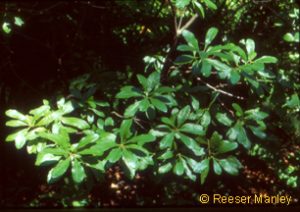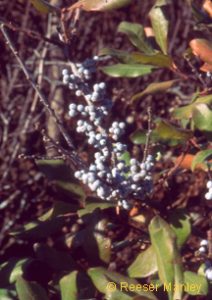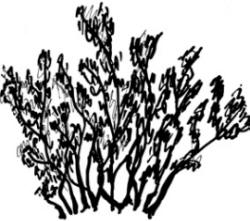Bulletin #2572, Native Trees and Shrubs for Maine Landscapes: Northern Bayberry (Myrica pensylvanica)
Developed by Marjorie Peronto, Associate Extension Professor, University of Maine Cooperative Extension; and Reeser C. Manley, Assistant Professor of Horticulture, University of Maine.
For information about UMaine Extension programs and resources, visit extension.umaine.edu.
Find more of our publications and books at extension.umaine.edu/publications/.
Go native!
This series of publications is the result of a five-year research project that evaluated the adaptability of a variety of native trees and shrubs to the stresses of urban and residential landscapes in Maine. Non-native invasive plants pose a serious threat to Maine’s biodiversity. Plants such as Japanese barberry, shrubby honeysuckle, and Asiatic bittersweet, originally introduced for their ornamental features, have escaped from our landscapes, colonizing natural areas and displacing native plants and animals. By landscaping with native plants, we can create vegetation corridors that link fragmented wild areas, providing food and shelter for the native wildlife that is an integral part of our ecosystem. Your landscape choices can have an impact on the environment that goes far beyond your property lines.
Description

Form: an open, rounded shrub with multiple stems and picturesque horizontal to ascending branches
Size: 6 to 12 feet high, commonly wider than it is tall
Ornamental characteristics:
- glossy, dark green summer foliage; leaves aromatic when crushed
- small, rounded, waxy-coated berries, white to gray in color and very fragrant, borne in clusters along the stem beneath the branch tips
Landscape Use

Northern bayberry is a common member of Maine’s coastal plant community, sharing this harsh and often droughty habitat with native roses (Rosa carolina), sweetfern (Comptonia peregrina), meadowsweet (Spiraea alba var. latifolia), and staghorn sumac (Rhus typhina), all intermingling in tall groundcover that is a mosaic of color and texture. Create a similar scene in your own landscape, taking advantage of this plant community’s tolerance for environmental stresses such as heat, drought, soil compaction, and salt.
In the garden, Myrica pensylvanica makes an excellent specimen plant or informal hedge, with the fragrant summer foliage providing a dark green background for the herbaceous or mixed border. It is also a must for the bird garden, as many winter birds eat the gray waxy-coated berries.
Remember that Northern bayberry is typically dioecious, so only female plants will bear fruit. However, you should include at least one male plant in your landscape to ensure adequate pollination.
Culture
Hardiness: USDA zone 4b

Soil requirements: tolerant of a wide variety of soils
Light requirements: full sun
Stress tolerances:
soil compaction — tolerant
pollution — unknown
deicing salts — tolerant
urban heat islands — tolerant
drought — tolerant
seasonal flooding — very tolerant
Insect and disease problems: infrequent
Wildlife Value
The winter fruits of bayberry are eaten by many bird species, including songbirds, waterfowl, shorebirds, and marsh birds. They are a preferred food of chickadees, red-bellied woodpeckers, tree swallows, catbirds, bluebirds, yellow-rumped warblers, and others. Bayberry thickets also provide nesting sites for songbirds, offering excellent protection from raccoons and other nest predators.
Maintenance
Irrigation: Water shrubs regularly for at least one year after planting. Apply 1 inch of water over the root zone once a week until leaves fall in autumn: in general, a shrub’s root zone extends twice as wide as its canopy. Once plants are established, further watering should not be necessary unless there are extended periods of drought.
Fertilization: Landscape trees and shrubs should not be fertilized unless a soil test indicates a need. Correct soil pH, if necessary, by amending the backfill soil. No nitrogen fertilizer should be added at planting or during the first growing season.
To learn more about native woody plants
Visit the Eastern Maine Native Plant Arboretum at University of Maine Cooperative Extension’s Penobscot County office, 307 Maine Avenue in Bangor. Established in 2004, the arboretum displays 24 different native tree and shrub species that can be used in managed landscapes.
Reviewed by Cathy Neal, Extension professor, University of New Hampshire Cooperative Extension.
Photos by Reeser C. Manley.
Illustration by Margery Read, Extension Master Gardener.
 This series of publications and the associated research were made possible in part by the Maine Forest Service’s Project Canopy.
This series of publications and the associated research were made possible in part by the Maine Forest Service’s Project Canopy.
Information in this publication is provided purely for educational purposes. No responsibility is assumed for any problems associated with the use of products or services mentioned. No endorsement of products or companies is intended, nor is criticism of unnamed products or companies implied.
© 2008
Call 800.287.0274 (in Maine), or 207.581.3188, for information on publications and program offerings from University of Maine Cooperative Extension, or visit extension.umaine.edu.
The University of Maine is an EEO/AA employer, and does not discriminate on the grounds of race, color, religion, sex, sexual orientation, transgender status, gender expression, national origin, citizenship status, age, disability, genetic information or veteran’s status in employment, education, and all other programs and activities. The following person has been designated to handle inquiries regarding non-discrimination policies: Sarah E. Harebo, Director of Equal Opportunity, 101 North Stevens Hall, University of Maine, Orono, ME 04469-5754, 207.581.1226, TTY 711 (Maine Relay System).

